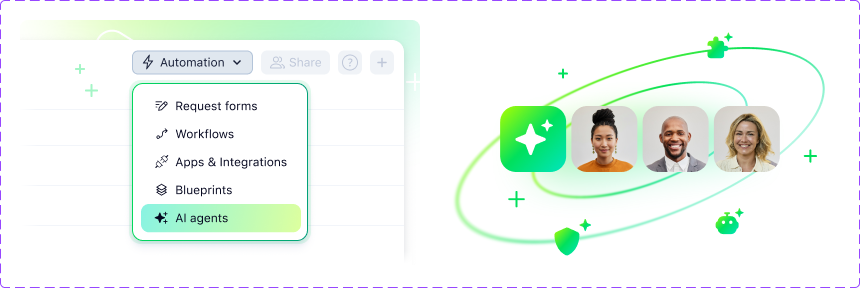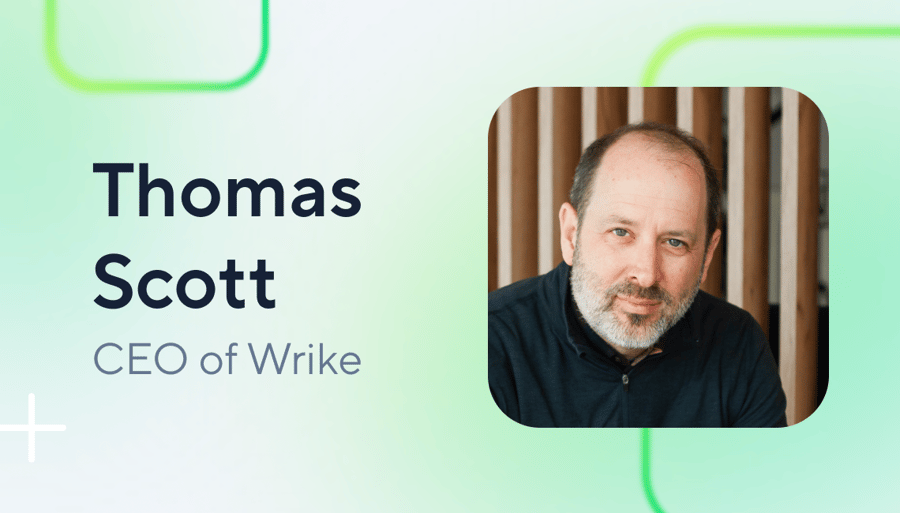I am a proponent of retail leadership. This means knowing stakeholders and their stories firsthand so you can make informed decisions. It means sharing stories across groups to provide key learnings and best practices. Wrike is a truly global company with employees and customers spread across the world. We have customers in 140 countries and employees across most time zones. This means I travel frequently, and over the course of three weeks, I made my way around the globe almost 1.5x to both listen to and tell stories as part of our Wrike Collaborate Roadshow.
We took our annual user conference on the road to ask very specific questions of our customers and uncover for ourselves:
- What is on everyone's mind as they seek to transform their business?
- What do different industries and regions have in common?
- How are companies experiencing the AI era? What are they actually doing?
But it wasn't just about listening. For me, it was also about challenging my own assumptions as CEO of Wrike. We have a point of view on how modern work gets done, and these conversations are a test of our vision against real-world scenarios and friction.
On the plane home last week, I started reflecting on all of the conversations the team and I have had over the past few weeks. Three topics came up again and again.
Top conversation topics
1. The pace and intensity of change in the AI era
There is no customer, region, or industry vertical that is immune to the rapid (and increasing) acceleration of change. I found it very difficult to differentiate this type of conversation from a global marketing agency based in EMEA to an APAC-based pharmaceutical company to a US-based professional services firm. Executives everywhere are pushing their teams to understand and deploy new technologies… and to backbrief them on how they can be deployed.
Since we are in uncharted territory, there is also a huge appetite to learn from other companies. During our customer panel discussions, we heard that all of them are planning to leverage AI, even if they don't feel they have it deployed to its full capabilities today. They are eager to hear how others are using it to capture best practices and use cases they can take back to their organizations.
One challenge universally faced: This acceleration is exacerbating long-standing issues with data hygiene and business outcomes.
2. The revenge of the legacy
Every company has a large collection of legacy sources of friction that stands in the way of the rapid implementation of change. This friction can take many forms:
- Multiple disparate systems of record
- Manual data entry
- Highly distributed teams
- Lack of alignment between executives and the business units
My team has actually heard from many PMO leaders who are actively moving away from unstructured ways of working to more structured and standardized approaches. The leaders who are brave enough to step up, cut through the noise, and establish a single system of record for work are the ones paving the way for true transformation. They understand that to move fast, you first need a solid foundation.
3. The impact of people
People's capacity to change is the big “difference maker.”
Change management was a hot topic during our customer panel sessions, with Wrike champions looking at how to remove friction and transform how their teams work and collaborate cross-functionally. All of this is compounding the fact that companies are growing globally, but they are still struggling to find the right way to undergo transformation as a distributed workforce.
What we found is that it is never about technology; it is about getting people to think differently as it relates to the rewiring of work. Most people are resistant to change because it is uncomfortable, but the increased pace is increasing this resistance. I heard this directly from executives at an APAC semiconductor company and a UK-based manufacturer.
Everyone was asking the same question in different ways: “How do we increase acceptance and adoption?” One of the biggest wins we heard: Success is immediate when employees can see the direct value to them — when it saves them time, removes friction, or solves a nagging problem.
Our observations
Those top conversation topics really resonated with me, but I also saw a lot of the solutions in the people I had the opportunity to talk to.
The importance of the “difference makers”
Leadership is the “difference maker” in successful transformations, and the groups I met with had many of the right building blocks:
- They were excited about what they were doing and wanted to share with others.
- They understood the power of storytelling to create momentum and adoption with their employees.
- They expressed urgency but paired this with a realism to experiment to find the right combination to solve problems for their business.
I saw leaders who were focused on building the proper space configurations, giving them the data foundation to apply intelligence and insights. Leaders working hands-on to build their own AI agents to replace fixed-rule automations. These champions lead by example and then enable change to broaden in an organization.

Specific use cases yield real value
Our customers are getting real ROI from Wrike because they are specifically applying it to complex problems:
- Coordinating global marketing campaigns at scale
- Managing hundreds of simultaneous client engagements for an audit/consulting firm
- Integrating acquisitions every month for a financial services firm
- Orchestrating multiyear drug approvals and product launches for a global pharmaceutical
This theme was brought to life on stage by our customer panelists, who talked about the need to apply specific solutions to meet the unique needs of their industry. The benefits of being able to easily build customized workflows and integrations that solve specific pain points and accelerate decisions and execution are invaluable.
The need to connect to executive-level audiences
Global executives are very interested in the possibilities of AI, but are not always deep into the details of the recipes needed to unlock this transformation for their organizations. I shared some (hopefully useful) tips on speaking to an executive audience and encouraging them to be very hands-on in this era of rewiring work.
My message to executives is the same: This is the time to be in the details and understand the tiny contributors to friction that gate larger value. I ask everyone I talk to about their personal use cases as a way to make a conversation about ROI real.
So, what does this all mean?
Meeting in person gives you the ability to challenge long-held assumptions about what is really important. What I found:
Human Intelligence + Artificial Intelligence = Organizational Intelligence
I walked into these customer sessions believing that humans still have a large role to play in value creation for the modern company. This has been a key theme I have been talking about for months, but I did want validation that our customers saw it the same way.
I walked out believing this role is more important than ever, as it is the dedicated “difference makers” who bring their passion and creativity to fighting through friction — both legacy systems and people's reluctance to change — in order to rewire work.

Solve customer pain now
Vision is essential, but a vision without a tangible path forward is just vaporware in the world of technology. In a market flooded with empty promises, we believe the most important thing is working closely with the “difference makers” on the ground. Our focus is on equipping them with shipped, functional tools to remove friction today, helping them unlock real transformation and earn buy-in with their teams now.
I'll end with a sincere thank you to the customers who attended and participated in our Collaborate event this year. It was unlike any other.
If you would like to hear (and learn) firsthand from Wrike customers who have been on the frontlines of their own transformation, we've extended Wrike Collaborate through the end of the year with an informative webinar series. Join us.







